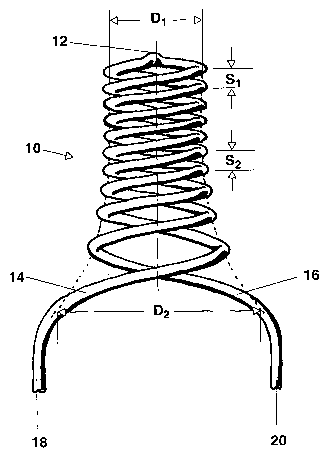Some of the information on this Web page has been provided by external sources. The Government of Canada is not responsible for the accuracy, reliability or currency of the information supplied by external sources. Users wishing to rely upon this information should consult directly with the source of the information. Content provided by external sources is not subject to official languages, privacy and accessibility requirements.
Any discrepancies in the text and image of the Claims and Abstract are due to differing posting times. Text of the Claims and Abstract are posted:
| (12) Patent Application: | (11) CA 2396929 |
|---|---|
| (54) English Title: | LUMINOUS ELEMENT FOR AN INCANDESCENT LAMP |
| (54) French Title: | ELEMENT LUMINEUX D'UNE LAMPE |
| Status: | Deemed Abandoned and Beyond the Period of Reinstatement - Pending Response to Notice of Disregarded Communication |
| (51) International Patent Classification (IPC): |
|
|---|---|
| (72) Inventors : |
|
| (73) Owners : |
|
| (71) Applicants : |
|
| (74) Agent: | SMART & BIGGAR LP |
| (74) Associate agent: | |
| (45) Issued: | |
| (86) PCT Filing Date: | 2000-11-30 |
| (87) Open to Public Inspection: | 2001-07-19 |
| Examination requested: | 2005-07-28 |
| Availability of licence: | N/A |
| Dedicated to the Public: | N/A |
| (25) Language of filing: | English |
| Patent Cooperation Treaty (PCT): | Yes |
|---|---|
| (86) PCT Filing Number: | PCT/DE2000/004272 |
| (87) International Publication Number: | WO 2001052305 |
| (85) National Entry: | 2002-07-10 |
| (30) Application Priority Data: | ||||||
|---|---|---|---|---|---|---|
|
The invention relates to a luminous element for a lamp. Said luminous element
(10) is double helix-shaped, with two connection parts (18, 20) situated at
one end of said double helix. The diameter (D1, D2) of the double helix
increases consistently in the direction of the two connection parts (18, 20)
of the luminous element (10). The invention also relates to a lamp with a
luminous element of this type, to a method for producing a luminous element of
this type and to a device for carrying out the production method.
L'invention concerne l'élément lumineux d'une lampe. Cet élément lumineux (10) a la forme d'une double hélice dont une extrémité est pourvue de deux raccordements (18, 20) et dont le diamètre (D1, D2) augmente progressivement en direction des deux raccordements (18, 20). L'invention concerne également une lampe dotée d'un tel élément lumineux, un procédé de production d'un tel élément lumineux et un dispositif permettant de mettre en oeuvre ce procédé de production.
Note: Claims are shown in the official language in which they were submitted.
Note: Descriptions are shown in the official language in which they were submitted.

2024-08-01:As part of the Next Generation Patents (NGP) transition, the Canadian Patents Database (CPD) now contains a more detailed Event History, which replicates the Event Log of our new back-office solution.
Please note that "Inactive:" events refers to events no longer in use in our new back-office solution.
For a clearer understanding of the status of the application/patent presented on this page, the site Disclaimer , as well as the definitions for Patent , Event History , Maintenance Fee and Payment History should be consulted.
| Description | Date |
|---|---|
| Application Not Reinstated by Deadline | 2008-12-01 |
| Time Limit for Reversal Expired | 2008-12-01 |
| Deemed Abandoned - Failure to Respond to Maintenance Fee Notice | 2007-11-30 |
| Letter Sent | 2005-08-24 |
| Amendment Received - Voluntary Amendment | 2005-08-12 |
| All Requirements for Examination Determined Compliant | 2005-07-28 |
| Request for Examination Received | 2005-07-28 |
| Request for Examination Requirements Determined Compliant | 2005-07-28 |
| Inactive: Cover page published | 2003-01-20 |
| Letter Sent | 2002-11-29 |
| Inactive: Notice - National entry - No RFE | 2002-11-29 |
| Application Received - PCT | 2002-09-17 |
| National Entry Requirements Determined Compliant | 2002-07-10 |
| Application Published (Open to Public Inspection) | 2001-07-19 |
| Abandonment Date | Reason | Reinstatement Date |
|---|---|---|
| 2007-11-30 |
The last payment was received on 2006-10-13
Note : If the full payment has not been received on or before the date indicated, a further fee may be required which may be one of the following
Please refer to the CIPO Patent Fees web page to see all current fee amounts.
| Fee Type | Anniversary Year | Due Date | Paid Date |
|---|---|---|---|
| Registration of a document | 2002-07-10 | ||
| Basic national fee - standard | 2002-07-10 | ||
| MF (application, 2nd anniv.) - standard | 02 | 2002-12-02 | 2002-10-21 |
| MF (application, 3rd anniv.) - standard | 03 | 2003-12-01 | 2003-10-21 |
| MF (application, 4th anniv.) - standard | 04 | 2004-11-30 | 2004-10-18 |
| Request for examination - standard | 2005-07-28 | ||
| MF (application, 5th anniv.) - standard | 05 | 2005-11-30 | 2005-10-14 |
| MF (application, 6th anniv.) - standard | 06 | 2006-11-30 | 2006-10-13 |
Note: Records showing the ownership history in alphabetical order.
| Current Owners on Record |
|---|
| PATENT-TREUHAND-GESELLSCHAFT FUER ELEKTRISCHE GLUEHLAMPEN MBH |
| Past Owners on Record |
|---|
| FELIX FRANCK |